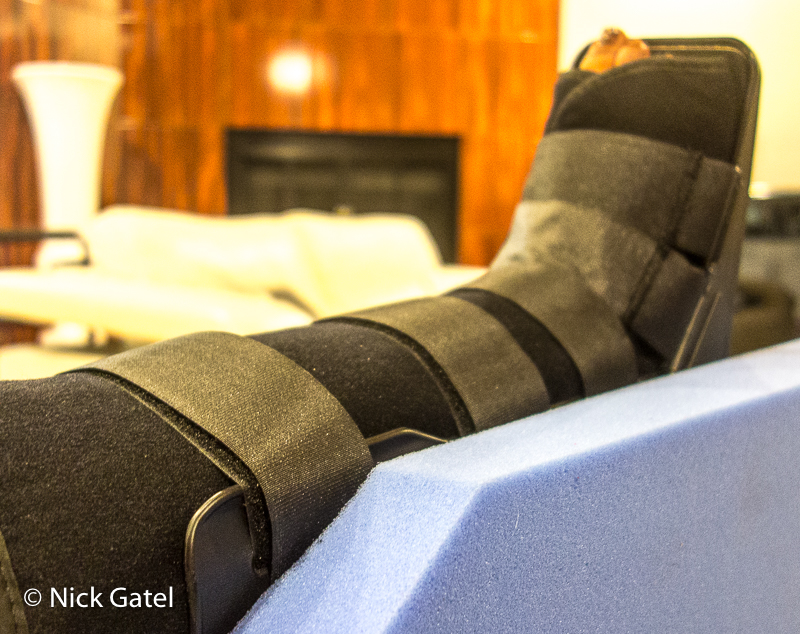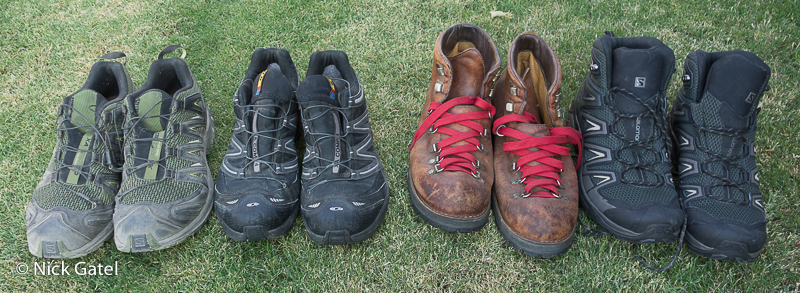A couple days ago Joyce had surgery for her broken ankle, which I shared in this post, An Epic Trip in More than One Way. As it turned out, she had three broken bones and will have to keep the ankle immobile for six weeks. The surgery included screws to help set the bones.
At the time of the injury she was wearing a pair of Salomon XA Pro 3D trail running shoes, not boots. Had she been wearing a pair of hiking boots instead, could the boots have prevented or minimalized the injury? Some people would say, “Yes,” others say, “No.”
Our Footwear Conversation
Perhaps it is ironic that we had an in depth discussion about boots and shoes the day before the injury. Joyce had been hiking in a pair of casual shoes because she couldn’t find her Salomon trail runners, which she normally keeps in our camper. She just assumed she had brought them into the house and left them at home.
I was pretty sure they were not in the house and suggested she look again. In the corner of her clothes closet she not only found the trail runners, but an old pair of Lowa Banff leather hiking boots. The boots are about 15 years old and she had quit wearing them when we both switched to the Salomon XA Pro 3D trail runners (me 12 years ago, she 10 years ago). The hiking boots were an expensive purchase when I bought a pair for each of us. The Lowa boots still fit her perfectly and she asked if it would be better to wear the boots.
At the time I expressed my opinion that boots offer no ankle “support.” They do protect against objects that can injure the outside of the foot, such as cactus thorns, sharp rocks, and even rattlesnake bites. But they will not prevent injuries; in fact they may cause injuries.
At the time, I told her to wear whatever she felt most comfortable with. She opted for the trail runners because in comparison, when walking around our campsite, the boots were extremely heavy.
Sometimes Experience is the Best Teacher
When I was in high school, I played basketball all four years. Each year I would get one or more fairly painful ankle sprains. So, I got into the habit of shaving my ankles and taping them.
In high school I also ran cross-country and track and never had an ankle injury. Sports like basketball and volleyball have fairly high incidents of ankle injuries, usually when the athlete has jumped in the air and landed on the side of the foot, causing a lateral force on the ankle.
When I started backpacking in high school, I just wore canvas tennis shoes because I couldn’t afford boots. They worked out just okay, mainly because they didn’t have great traction.
When I got out of the Air Force, I bought a pair of Pivetta DMC hiking boots. I wore these for about 15 years, and then switched to a pair of Danner Mountain Lights because the soles and especially the heels were wider. Over the years, one thing I noticed with wearing boots, is I would occasionally stumble over exposed roots or rocks, something that did not happen when day hiking with running shoes. Lightweight shoes allow one to react much quicker. So about 15 years ago or so, I started wearing running shoes. Running shoes worked much better for sure-footedness and the much lighter weight allowed me to hike more miles with less fatigue.
The Purpose of Footwear
I have written several articles about shoes and boots on this blog (type “shoes” or “boots” in the search box at the top of the page if you want to view them). I have consistently written since I started this site 12 years ago, that
The main purpose of footwear is to protect the bottom of the foot from external objects.
I don’t think I have ever made a statement regarding foot support or ankle support.
Research
Prior to writing this post, I have never delved into the shoes vs. boots conversation, other than boots are heavy. There is one exception: an article I wrote earlier this year, Thoughts on Boots and Boot Care. The point of this post was how to maintain boots, plus I am beginning to wear boots again. There are two reasons for this:
- Trail running shoes don’t last long, are expensive, and end up in landfills.
- Boots offer more protection against obstacles, primarily cactus spines and sharp rocks.
Joyce’s accident gave me pause to think about footwear, and to do some research. A casual Google search is going to first bring up articles written by “experts” for (online and paper) magazines or retailers that sell boots. Of course magazines get income from ads, retailers from selling stuff to consumers. Of course boots, especially quality leather boots, cost much more than trail running shoes. Who would have guessed?
When I read these articles about boots, often the first sentence is something like, “Boots provide ankle support.” There is no further discussion or an explanation of what support means.
Many articles written by foot doctors begin the same way without any science to justify the claim. Perhaps all these authors have some extraordinary knowledge provided by some Divine source.
Instead of posting individual resources, I stumbled upon this Reddit post with a lot of great information and links to 8 articles, 6 of which are scientific studies. The author summarized with this statement:
The consensus seems to be that orthopedic braces are effective at reducing ankle injuries but that high-top boots are not any more effective than regular footwear, or such evidence is inconclusive. People who cling to the “boots prevent ankle injury” myth may be confusing bracing and high-top footwear, where the former is post-injury treatment – an immobilizer – and the latter is just advertiser hype.
Even the statement, “. . . orthopedic braces are effective at reducing ankle injuries” is subject to debate. It does appear that some devices can help prevent re-injury.
Next Steps
The most important thing in preventing ankle injuries is fairly simple: developing strong ankles, that is, strengthening and stretching ankles. Some research indicates that boots actually weaken the muscles in the foot increasing the chances of injury.
After Joyce’s ankle heals, she’ll be going through physical therapy. Hopefully we’ll get a good therapist. At the same time, I’ll be comparing the therapist’s recommendation against some of the research I have done. Should the therapist (or our doctor) recommend an orthopedic brace, we’ll probably do that depending on how it is to be used. We have no problem with getting 2nd opinions.
I have checked into possible braces and this one seems to be highly recommended.
This website may be compensated for linking to other sites or for sales of products. As an Amazon Associate I earn a small fee from qualifying purchases at no additional cost to the purchaser.

